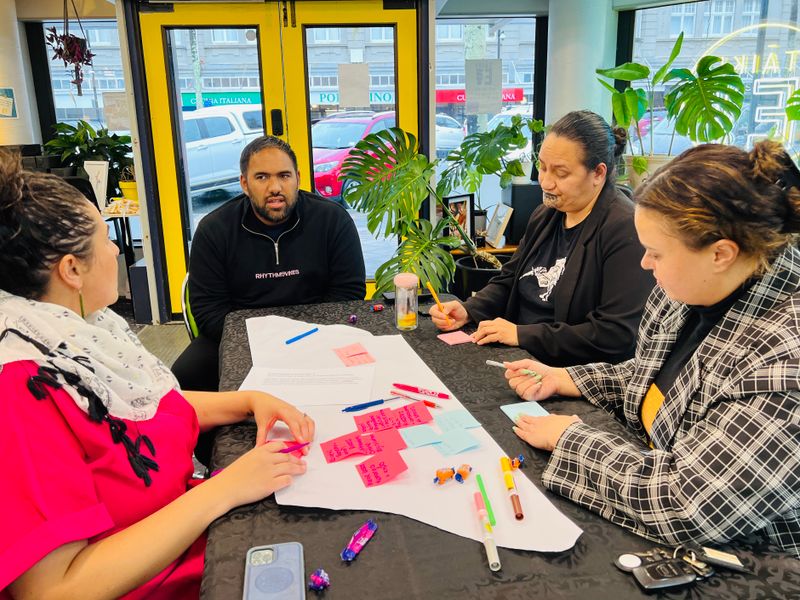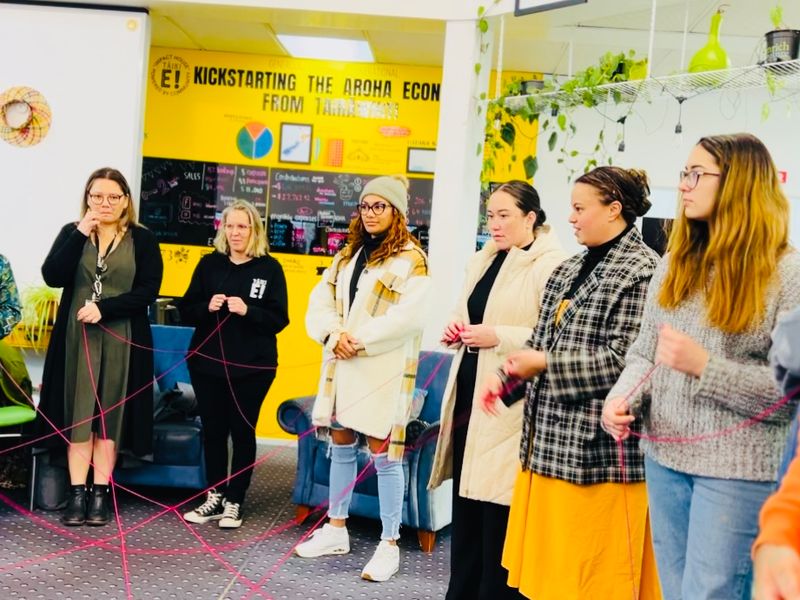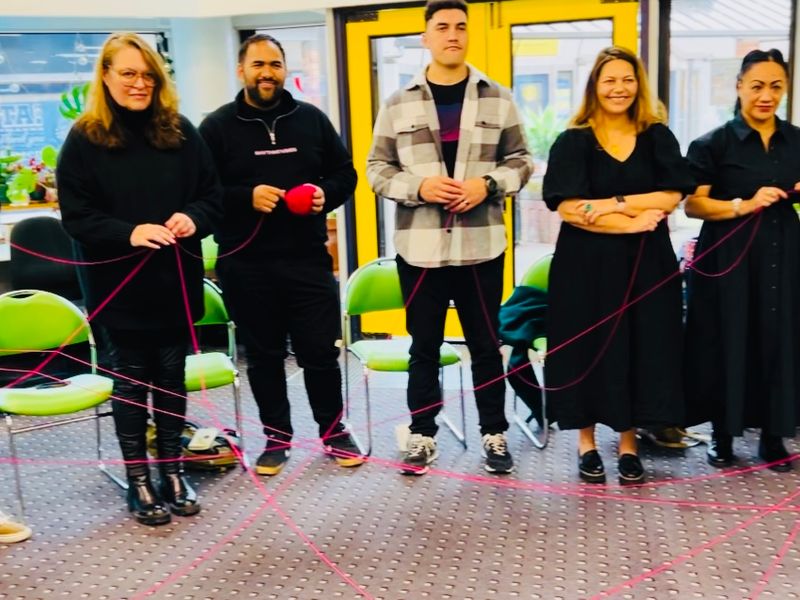Empowering Voices: Reflections on the Tairāwhiti Māori Comms Hui
In the heart of Turanganui-ā-Kiwa, the first Tairāwhiti Māori Communications Hui gathered 25 Māori professionals from the communications and storytelling industry for a day of connection, learning and inspiration. This event celebrated Māori storytelling and emphasised the role that Māori communications plays in shaping narratives, challenging stereotypes, and preserving Māori cultural heritage.
 Tairāwhiti Māori Comms Hui
Tairāwhiti Māori Comms Hui
What an incredible day in the Tāiki e! whare.
Amplifying Māori Voices
Māori communications helps to amplify Māori voices, preserve culture and heritage, and empower Iwi, Hapū, Whānau and Māori communities. The hui celebrated the significance of having Māori communicators share stories and experiences authentically. Māori communicators bring a depth of cultural insight, authenticity, and a holistic worldview that challenges external perspectives.
Cherish Wilkinson, one of our Tāiki e! whānau members, was the driving force behind the hui. Recognising the need for a space where Māori working in communications could unite, learn, and create a path for the future, she and the Tāiki e! whānau brought the hui to life.
Cherish, who has worked in communications and marketing for over a decade, shared,
‘there are so many stories to be told and we need more of our whānau Māori in this space to entrust our stories and voices to.’
“To see what started as a little Facebook post to my networks turn into a full day hui has been humbling and reaffirming that we can create opportunities for our people working in comms to come together,” said Cherish.
Empowerment through Storytelling
Empowerment through storytelling was a reoccurring theme at the hui. Māori communicators understand the power of narratives to shape perceptions and pave the way for positive change.
Some of the participants talked to reclaiming Māori narratives and creating space for future generations to thrive in a culture that values authenticity.
Eru West, a participant at the hui invited other Māori communicators to lead their own content creation processes.
“In my experience, Māori practitioners have always played a big role in the comms/media/storytelling landscape. After this hui though, I'm more confident that we're creating systems and enabling pakihi, to be able to do this for the value that it's worth, rather than having to juggle a million things and barely get any credit for it,” said Eru.
Kahurangi Moke talked about upholding the legacy of stories and kōrero tuku iho.
“Growing up I always enjoyed listening to stories and kōrero from my nannies and papas about different kaupapa from back in their day. Ensuring that these stories live on for future generations became a driving force in my decision to study communications,” said Kahurangi.
“I would love to see increased Māori representation across all communication areas, disrupting the Eurocentric media norm. This entails the promotion of Māori narratives in the media, along with the promotion of creative and immersive Māori storytelling. Ultimately, a holistic approach, blending accessible education, mentorship, representation, and collaboration, will foster a more inclusive Māori presence in storytelling and communications.”
Sharing Insights and Building Connections
The agenda of the hui fostered connections and learning. The mihi whakatau set the tone for openness and collaboration. The Tātai Hono string game created the right vibe for whakawhanaungatanga, weaving the many ties and bonds across the rōpū.
Lightning Talks quick-fire presentations highlighted the diverse local talent in Tairāwhiti. Presenter Rina Kerekere (KE Design and CEO of Hauiti Hauora) shared her journey of telling Māori stories through mahi toi. Haimona Ngata presented on video storytelling being a powerful tool for telling stories from a Māori perspective and the importance of being connected to the people and kaupapa when retelling stories. Rawinia Parata presented on Te Ara Patupaiarehe, an interpretation and celebration of traditional Ngāti Porou folklore, a physical and virtual experience on Manutahi Hill in Ruatoria brought to life by the local Kura with the support of local organisations. Tee Montgomery talked to responding to our region’s extreme weather events through her Civil Defence Management mahi at Te Runanganui o Turanganui-ā-Kiwa, still dealing with the mamae from Cyclone Gabrielle.
Guest speaker Renee Raroa emphasised the significance of telling stories from a cultural and holistic perspective. Her insights highlighted the transformative power of Māori communications, representing the richness of Māori culture and experiences.
Renee is Tairāwhiti Lead at Toha, and representative of Mana Taiao Tairāwhiti and Te Weu Charitable Trust, East Coast Exchange and Te Roopu Taiao. You can read more about Renee and her visit to the UN Permanent Forum on Indigenous Issues in New York in this Gisborne Herald article.
 Tairāwhiti Māori Comms Hui
Tairāwhiti Māori Comms Hui
Building Bridges through Innovation
A standout activity of the hui was the communications innovation design sprint. Participants developed solutions rooted in Māori values. The focus of the sprint was on fostering connections, collaboration and creativity. This showcased the potential for Māori communicators to drive innovation through their unique perspectives.
Verona Putaranui, who took part in the sprint shared, ‘it was fun imagining solutions to some real and crunchy challenges like civics and increasing voter participation.’
The communications sprint was also a highlight for Ranui Maxwell.
“The best part would have to be the Kaikōrero that presented and the design challenge. It really highlighted the exceptional talent we have in the comms space. The design challenge was an awesome opportunity to solve some of our most challenging issues facing us as Kaimahi,” said Ranui.
A Path Forward
As the hui ended, the reflections and insights shared by participants showcased the profound impact of the hui.
Eru West shared his enthusiasm for the future of Māori communications and storytelling.
“I'm really excited for this next phase where we actually find and resource our own experts to capture and share the awesome stories we have in each rohe,” said Eru.
Kahurangi Moke described the hui as being uplifting.
“As a young wāhine Māori who recently graduated with a Bachelor of Communications in Media Studies, this hui uplifted me by showing the existing talent in Tairāwhiti’s Māori communications scene. It revealed a strong network of Māori communication professionals right here at home,” said Kahurangi.
Verona Putaranui reflected on the demand for Māori communicators and pathways for the future.
“Māori talent will continue to be in demand - and roles for Māori communications practitioners will continue to grow. Currently we are small in numbers, fragmented, and support mechanisms for practitioners are ad hoc. There are no formal quals or development programmes for career pathways.
“We have many opportunities in our future. In the short term, working together to power up our ability to deliver campaigns and products. Our inaugural gathering really profiled our broad range of skill sets. This highlighted we’re not in competition, we can be complementary and collaborative to each other’s efforts.
Ranui Maxwell talked to the importance of kotahitanga amongst the network.
“As Māori comms professionals we have a responsibility, but we also have power as a collective. My aspirations are that we grow as a network and meet regularly. That we can keep each other safe and accountable. Support one another,” said Ranui.
Reflections
For Cherish Wilkinson, her own reflections, and reasons for wanting to bring Māori communicators in Tairāwhiti together still hold true.
It is a privilege to tell and share our stories.
Too often communicators are disconnected from the people and the stories. We need to be telling stories from within kaupapa and communities as opposed to telling them from outside.
Māori communicators bring a depth of cultural insight, authenticity, and a holistic worldview to storytelling. It’s crucial to have authentic representation and understanding when telling those stories.
Telling stories from within a community, rather than an outsider’s perspective, allows for a deeper understanding and resonance. It ensures that the cultural nuances, values and perspectives are accurately conveyed. Māori communicators, with their cultural knowledge and connection to Whānau, Hapū, Iwi and Māori communities, have the ability to bring out the true essence of the stories they share.
Māori principles such as kanohi ki te kanohi (face to face communication) and he kanohi kitea (building and maintaining relationships that are sustainable and build two-way dialogue, not one-way information provision) are known qualities and provide a baseline so that kōrero can continue with confidence. More importantly, that once initiated, continuity of the relationship is maintained. These principles not only foster trust and understanding but also ensure that communications is a two-way process, where both sides listen and engage.
We operate and produce our best mahi when we work together.
Māori talent is in hot demand, both in the private and public sector, and roles for Māori communicators will continue to grow. Throughout the hui we heard that there are not enough Māori communicators and storytellers, and often those working in Māori communications roles are fragmented, working alone and/or in isolation of other Māori communicators, with little to no support.
By uniting our diverse skills, we can foster a cooperative environment where Māori practitioners can thrive. In the short term this could look like Māori communicators coming together to develop and implement micro projects, campaigns and products as avenues for showcasing our capabilities.
In the long term, this could look like testing a cooperative model. Early identification of local Māori talent and tailored development initiatives could help to nurture emerging Māori communicators and storytellers. Offering meaningful employment opportunities within our communities could also empower practitioners but also enrich our communities too.
Partnering with education providers could address the need for formal development programmes, qualifications and learning pathways for more Māori to get into communications.
Regular gatherings and advocacy efforts, such as holding more Māori communications hui, can also amplify the visibility of Māori voices and stories.
We should think more deeply around the stories we are telling now and if they serve a higher purpose.
Sustaining relationships is crucial in storytelling, as it allows for ongoing kōrero and the sharing of narratives across generations. It ensures that the stories are not just told once but are woven into the fabric of Whānau, Hapū, Iwi, Māori communities, continually enriching our cultural heritage.
By upholding Māori principles and tikanga (practices), Māori communicators contribute to preserving Māori cultural identity and fostering a sense of unity and pride among their people. Our holistic worldview and respect for tikanga, combined with effective communication skills, serve as a bridge between past, present and future, allowing stories to be passed down and cherished for generations to come.
 Tairāwhiti Māori Comms Hui
Tairāwhiti Māori Comms Hui
Conclusion
The Tairāwhiti Māori Communications Hui was a day to celebrate Māori storytelling, unity, and empowerment. Māori talent, creativity and determination of Māori communicators to drive positive change through narratives that reflect Māori perspectives and culture.
This hui serves as an inspiration for not only Māori professionals but for anyone that believes in the power of authentic storytelling. It demonstrates that when voices unit, when narratives are shaped by those who understand them best, and when communities come together, the impact can be profound and far-reaching.
The legacy of this hui will undoubtedly shape the landscape of Māori communications here at home in Tairāwiti, and hopefully, around the motu for years to come, challenging narratives, and empowering Māori communities through the art of storytelling.
Read more from Tāiki e!
- 19 September 2025 Friday karakia and waiata at Gisborne’s Treble Court to be regular community event — Gisborne Herald
- 30 April 2024 Making hope actionable, together!
- 06 December 2023 Strengthening our collective muscle during GEW
- 08 August 2023 Tairāwhiti Unconference 2023: a conference designed by you
- 26 April 2023 In 54 hours from 'Imagine if' to 'Here's how'
